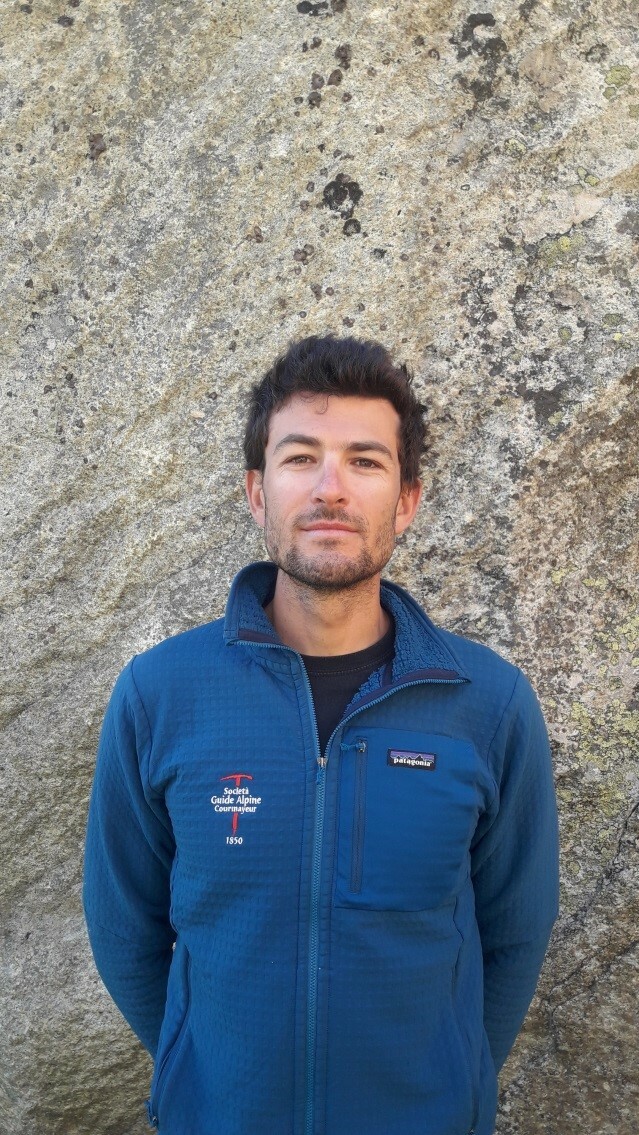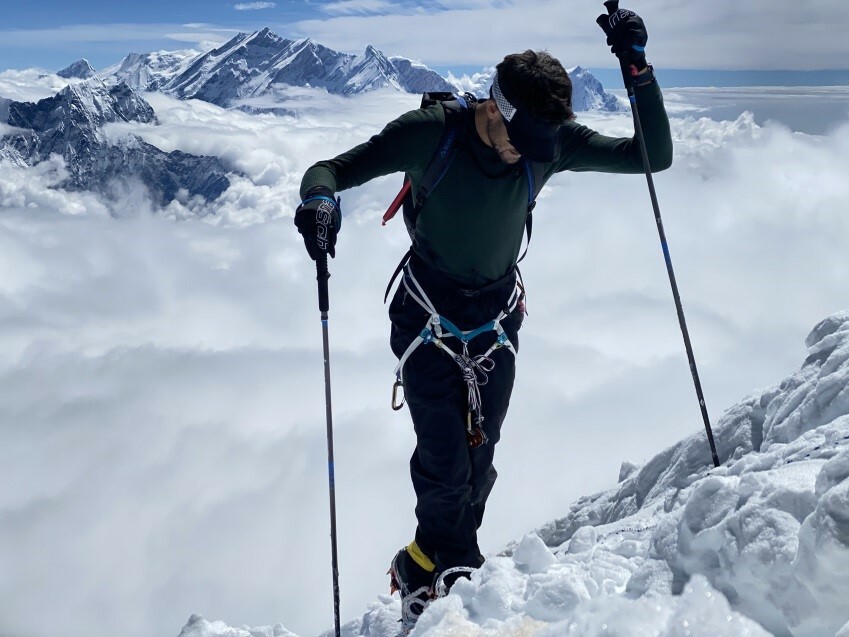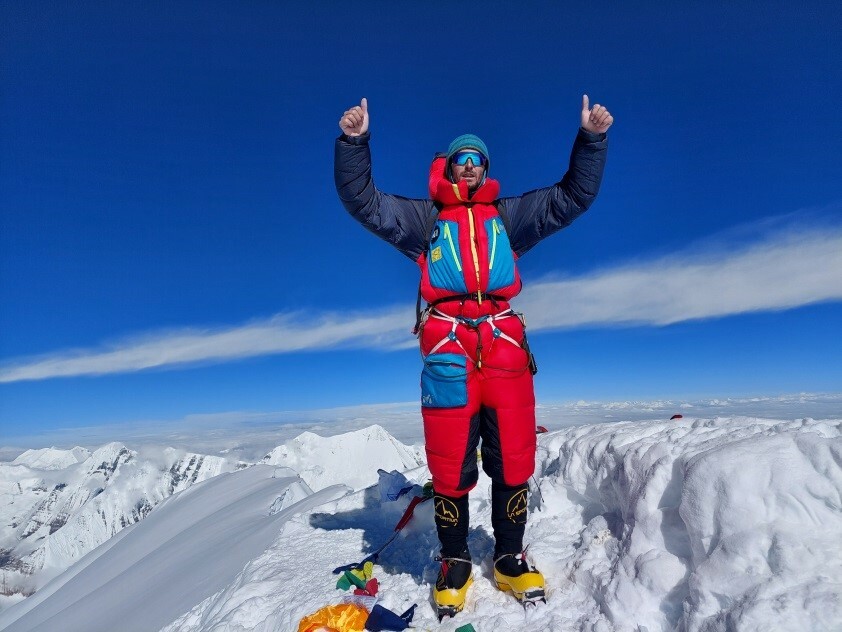My name is Pietro Picco, I live in Courmayeur at the feet of Mont Blanc and work as a mountain guide. I grew up reading about the great climbers’ adventures, in the Alps and all over the world. The stories that captured me the most were those in the Himalaya, where at 8000 meters the air is so thin that it is impossible to walk continuously and every few steps one must stop to catch his breath. I had this dream that one day I could be one of those lucky people to climb in the Himalaya.
In recent years this idea never left my mind but it always felt like an objective that was a bit too ambitious. I have seen that as one progresses in his climbing career some climbs fix benchmarks, to which you always end up comparing the most recent climbs, and none felt like a good enough preparation for the Himalaya. The climb that probably left the greatest impression in me is the Peuterey Integral ridge, that I climbed in 2016 with my friend Aldo. After that, a friend of mine who’d recently come back from climbing in the Chalten-Fitzroy Massif in Patagonia told me that even the easiest climbs there were as complex as the Peuterey Integral. So going to Patagonia seemed like the logical step up from all the climbing I’d done before. Patagonia really was the next thing, and I went there twice managing to climb Cerro Torre via the Ragni route in 2020, a massive satisfaction.
1 custom-html
So I spent last summer guiding clients in the Alps, mostly around Courmayeur, asking myself which would be the next project. One day I organized to take my mum and a friend of hers to Breithorn, for their first 4000er. As we got on the cablecar in Cervinia, I just happened to meet Marco Camandona, a guide from Aosta. We did most of the climb together, chatting occasionally. As we were on top of the mountain, Marco suggested: would you like to come to Nepal with me this autumn? Marco is a well experienced Himalaist having already climbed nine 8000ers, mostly in Nepal. Only 8000er left for him was Dhaulagiri, at 8167m the seventh highest mountain on Earth.
I immediately accepted and we quickly organized everything to be able to leave on the 29th of August.
We flew into Kathmandu, then Pokhara and Marpha, last village before the trek to basecamp. It was great to finally leave civilization and camp for two nights before arriving to the spot where we set up our BaseCamp on the glacier. We spent two days organizing our tents and gear.
Basecamp is an interesting universe, as you are camping in a really inhospitable place that is constantly moving! We woke quite often up in the morning with our tents covered in snow.
Our first move up was to take a tent and some equipment. We found ourselves making trail in deep snow, taking it in turns with the Sherpas, with whom we established a very friendly relationship. In mid afternoon the Sherpas turned back, leaving us alone on the mountain. We arrived at 5800mt, which we called our Camp1 and slept there for the night. The following morning we climbed up to 6400m and decided we would establish our Camp 2 there. We then returned to basecamp, as part of the acclimatization strategy.
One of the thoughts that filled my mind before leaving for the trip was: how will it feel up there? Will I be sick? Being with Marco, trusting his experience we stuck to our acclimatization plan and things went quite smoothly. I could feel the altitude while walking, but we kept a very slow and steady pace. The biggest problem I had were strong headaches at night, especially during acclimatization trips when we would crawl in our sleeping bags at 4pm and stay inside the tent all night until sunrise at 8AM.
On our second trip up we went directly to 6400 and slept there two nights, making it up to 7250m on one day. Once we were down, and after recovering for a couple days, trusting Marco’s experience, we were ready for the summit push.
1 custom-html
After a few days rest we left basecamp with our big boots, clear sign we were heading as high as possible. We slept at our camp at 6400, then had to wait for another night as the weather forecast had changed.
Finally, at 10 AM on the 30th of September we left our camp, arriving in mid afternoon at the highest camp at 7250m, we only brought our jetboil, and had a quick bite and a rest.
At 10PM we left into the dark. A steep snow ramp led us to a sharp ridge and a long traverse. We made our way up, going slower and slower. At one point, around 8000m we could not walk continuously anymore, and had to take a few steps then stop. This was the coldest moment, we were high on the mountain and just before sunrise. But we had our full down suits keeping us warm. The last 100 meters we climbed up a steep couloir, and at 8AM we stood on the summit of Dhaulagiri!
1 custom-html
It was a great adventure and experience, and I can say a dream come true!
A massive thanks to Blue Ice for supporting me with their gear, I am a fanatic of fast and light gear and theirs is the best around! Here is a list of the products I used in the trip:
Dragonfly 45L Backpack. Perfect for this kind of trip! Used it to carry all the bulky gear to the various camps and took it half empty to the summit!
Akila Adze Ice axe. Very complete ice axe for anything from classical mountaineering to easy ice climbing
Choucas light harness. So good you don’t notice you’re wearing it!
Aero Lite Ice screws. Great piece of protection, carry two for the weight of one. Perfect for glacier safety and ice climbing.
1 DHAULAGIRI 2021 by Pietro Picco Discover the story of Pietro Picco who climbed in 2021 the 7th highest peak on earth - DHAULAGIRI Light 1 light https://content.admin.blueice.com/media/images/news/749631/Cerro-Torre-2020-Ragni-Route.jpg 722 541 Cerro Torre 2020 Ragni Route image/jpeg 77744 text DHAULAGIRI 2021 by Pietro PiccoMy name is Pietro Picco, I live in Courmayeur at the feet of Mont Blanc and work as a mountain guide. I grew up reading about the great climbers’ adventures, in the Alps and all over the world. The stories that captured me the most were those in the Himalaya, where at 8000 meters the air is so thin that it is impossible to walk continuously and every few steps one must stop to catch his breath. I had this dream that one day I could be one of those lucky people to climb in the Himalaya.
In recent years this idea never left my mind but it always felt like an objective that was a bit too ambitious. I have seen that as one progresses in his climbing career some climbs fix benchmarks, to which you always end up comparing the most recent climbs, and none felt like a good enough preparation for the Himalaya. The climb that probably left the greatest impression in me is the Peuterey Integral ridge, that I climbed in 2016 with my friend Aldo. After that, a friend of mine who’d recently come back from climbing in the Chalten-Fitzroy Massif in Patagonia told me that even the easiest climbs there were as complex as the Peuterey Integral. So going to Patagonia seemed like the logical step up from all the climbing I’d done before. Patagonia really was the next thing, and I went there twice managing to climb Cerro Torre via the Ragni route in 2020, a massive satisfaction.
1 custom-html
So I spent last summer guiding clients in the Alps, mostly around Courmayeur, asking myself which would be the next project. One day I organized to take my mum and a friend of hers to Breithorn, for their first 4000er. As we got on the cablecar in Cervinia, I just happened to meet Marco Camandona, a guide from Aosta. We did most of the climb together, chatting occasionally. As we were on top of the mountain, Marco suggested: would you like to come to Nepal with me this autumn? Marco is a well experienced Himalaist having already climbed nine 8000ers, mostly in Nepal. Only 8000er left for him was Dhaulagiri, at 8167m the seventh highest mountain on Earth.
I immediately accepted and we quickly organized everything to be able to leave on the 29th of August.
We flew into Kathmandu, then Pokhara and Marpha, last village before the trek to basecamp. It was great to finally leave civilization and camp for two nights before arriving to the spot where we set up our BaseCamp on the glacier. We spent two days organizing our tents and gear.
Basecamp is an interesting universe, as you are camping in a really inhospitable place that is constantly moving! We woke quite often up in the morning with our tents covered in snow.
Our first move up was to take a tent and some equipment. We found ourselves making trail in deep snow, taking it in turns with the Sherpas, with whom we established a very friendly relationship. In mid afternoon the Sherpas turned back, leaving us alone on the mountain. We arrived at 5800mt, which we called our Camp1 and slept there for the night. The following morning we climbed up to 6400m and decided we would establish our Camp 2 there. We then returned to basecamp, as part of the acclimatization strategy.
One of the thoughts that filled my mind before leaving for the trip was: how will it feel up there? Will I be sick? Being with Marco, trusting his experience we stuck to our acclimatization plan and things went quite smoothly. I could feel the altitude while walking, but we kept a very slow and steady pace. The biggest problem I had were strong headaches at night, especially during acclimatization trips when we would crawl in our sleeping bags at 4pm and stay inside the tent all night until sunrise at 8AM.
On our second trip up we went directly to 6400 and slept there two nights, making it up to 7250m on one day. Once we were down, and after recovering for a couple days, trusting Marco’s experience, we were ready for the summit push.
1 custom-html
After a few days rest we left basecamp with our big boots, clear sign we were heading as high as possible. We slept at our camp at 6400, then had to wait for another night as the weather forecast had changed.
Finally, at 10 AM on the 30th of September we left our camp, arriving in mid afternoon at the highest camp at 7250m, we only brought our jetboil, and had a quick bite and a rest.
At 10PM we left into the dark. A steep snow ramp led us to a sharp ridge and a long traverse. We made our way up, going slower and slower. At one point, around 8000m we could not walk continuously anymore, and had to take a few steps then stop. This was the coldest moment, we were high on the mountain and just before sunrise. But we had our full down suits keeping us warm. The last 100 meters we climbed up a steep couloir, and at 8AM we stood on the summit of Dhaulagiri!
1 custom-html
It was a great adventure and experience, and I can say a dream come true!
A massive thanks to Blue Ice for supporting me with their gear, I am a fanatic of fast and light gear and theirs is the best around! Here is a list of the products I used in the trip:
Dragonfly 45L Backpack. Perfect for this kind of trip! Used it to carry all the bulky gear to the various camps and took it half empty to the summit!
Akila Adze Ice axe. Very complete ice axe for anything from classical mountaineering to easy ice climbing
Choucas light harness. So good you don’t notice you’re wearing it!
Aero Lite Ice screws. Great piece of protection, carry two for the weight of one. Perfect for glacier safety and ice climbing.
1 DHAULAGIRI 2021 by Pietro Picco Discover the story of Pietro Picco who climbed in 2021 the 7th highest peak on earth - DHAULAGIRI Light 1 light https://content.admin.blueice.com/media/images/news/749631/Cerro-Torre-2020-Ragni-Route.jpg 722 541 Cerro Torre 2020 Ragni Route image/jpeg 77744 text DHAULAGIRI 2021 by Pietro PiccoMy name is Pietro Picco, I live in Courmayeur at the feet of Mont Blanc and work as a mountain guide. I grew up reading about the great climbers’ adventures, in the Alps and all over the world. The stories that captured me the most were those in the Himalaya, where at 8000 meters the air is so thin that it is impossible to walk continuously and every few steps one must stop to catch his breath. I had this dream that one day I could be one of those lucky people to climb in the Himalaya.
In recent years this idea never left my mind but it always felt like an objective that was a bit too ambitious. I have seen that as one progresses in his climbing career some climbs fix benchmarks, to which you always end up comparing the most recent climbs, and none felt like a good enough preparation for the Himalaya. The climb that probably left the greatest impression in me is the Peuterey Integral ridge, that I climbed in 2016 with my friend Aldo. After that, a friend of mine who’d recently come back from climbing in the Chalten-Fitzroy Massif in Patagonia told me that even the easiest climbs there were as complex as the Peuterey Integral. So going to Patagonia seemed like the logical step up from all the climbing I’d done before. Patagonia really was the next thing, and I went there twice managing to climb Cerro Torre via the Ragni route in 2020, a massive satisfaction.
1 custom-html
So I spent last summer guiding clients in the Alps, mostly around Courmayeur, asking myself which would be the next project. One day I organized to take my mum and a friend of hers to Breithorn, for their first 4000er. As we got on the cablecar in Cervinia, I just happened to meet Marco Camandona, a guide from Aosta. We did most of the climb together, chatting occasionally. As we were on top of the mountain, Marco suggested: would you like to come to Nepal with me this autumn? Marco is a well experienced Himalaist having already climbed nine 8000ers, mostly in Nepal. Only 8000er left for him was Dhaulagiri, at 8167m the seventh highest mountain on Earth.
I immediately accepted and we quickly organized everything to be able to leave on the 29th of August.
We flew into Kathmandu, then Pokhara and Marpha, last village before the trek to basecamp. It was great to finally leave civilization and camp for two nights before arriving to the spot where we set up our BaseCamp on the glacier. We spent two days organizing our tents and gear.
Basecamp is an interesting universe, as you are camping in a really inhospitable place that is constantly moving! We woke quite often up in the morning with our tents covered in snow.
Our first move up was to take a tent and some equipment. We found ourselves making trail in deep snow, taking it in turns with the Sherpas, with whom we established a very friendly relationship. In mid afternoon the Sherpas turned back, leaving us alone on the mountain. We arrived at 5800mt, which we called our Camp1 and slept there for the night. The following morning we climbed up to 6400m and decided we would establish our Camp 2 there. We then returned to basecamp, as part of the acclimatization strategy.
One of the thoughts that filled my mind before leaving for the trip was: how will it feel up there? Will I be sick? Being with Marco, trusting his experience we stuck to our acclimatization plan and things went quite smoothly. I could feel the altitude while walking, but we kept a very slow and steady pace. The biggest problem I had were strong headaches at night, especially during acclimatization trips when we would crawl in our sleeping bags at 4pm and stay inside the tent all night until sunrise at 8AM.
On our second trip up we went directly to 6400 and slept there two nights, making it up to 7250m on one day. Once we were down, and after recovering for a couple days, trusting Marco’s experience, we were ready for the summit push.
1 custom-html
After a few days rest we left basecamp with our big boots, clear sign we were heading as high as possible. We slept at our camp at 6400, then had to wait for another night as the weather forecast had changed.
Finally, at 10 AM on the 30th of September we left our camp, arriving in mid afternoon at the highest camp at 7250m, we only brought our jetboil, and had a quick bite and a rest.
At 10PM we left into the dark. A steep snow ramp led us to a sharp ridge and a long traverse. We made our way up, going slower and slower. At one point, around 8000m we could not walk continuously anymore, and had to take a few steps then stop. This was the coldest moment, we were high on the mountain and just before sunrise. But we had our full down suits keeping us warm. The last 100 meters we climbed up a steep couloir, and at 8AM we stood on the summit of Dhaulagiri!
1 custom-html
It was a great adventure and experience, and I can say a dream come true!
A massive thanks to Blue Ice for supporting me with their gear, I am a fanatic of fast and light gear and theirs is the best around! Here is a list of the products I used in the trip:
Dragonfly 45L Backpack. Perfect for this kind of trip! Used it to carry all the bulky gear to the various camps and took it half empty to the summit!
Akila Adze Ice axe. Very complete ice axe for anything from classical mountaineering to easy ice climbing
Choucas light harness. So good you don’t notice you’re wearing it!
Aero Lite Ice screws. Great piece of protection, carry two for the weight of one. Perfect for glacier safety and ice climbing.
1 DHAULAGIRI 2021 by Pietro Picco Discover the story of Pietro Picco who climbed in 2021 the 7th highest peak on earth - DHAULAGIRI Light 1 light


